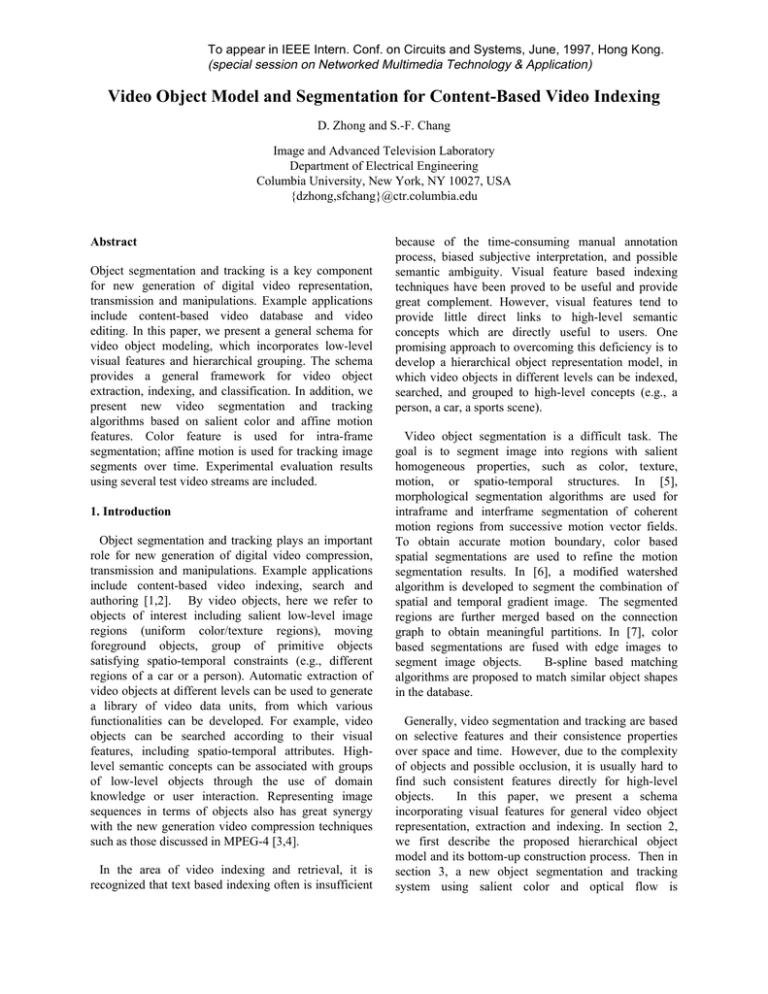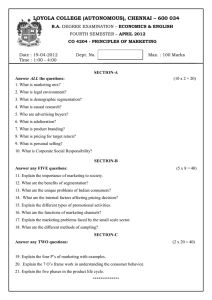Abstract because of the time-consuming manual annotation
advertisement

To appear in IEEE Intern. Conf. on Circuits and Systems, June, 1997, Hong Kong.
(special session on Networked Multimedia Technology & Application)
Video Object Model and Segmentation for Content-Based Video Indexing
D. Zhong and S.-F. Chang
Image and Advanced Television Laboratory
Department of Electrical Engineering
Columbia University, New York, NY 10027, USA
{dzhong,sfchang}@ctr.columbia.edu
Abstract
Object segmentation and tracking is a key component
for new generation of digital video representation,
transmission and manipulations. Example applications
include content-based video database and video
editing. In this paper, we present a general schema for
video object modeling, which incorporates low-level
visual features and hierarchical grouping. The schema
provides a general framework for video object
extraction, indexing, and classification. In addition, we
present new video segmentation and tracking
algorithms based on salient color and affine motion
features. Color feature is used for intra-frame
segmentation; affine motion is used for tracking image
segments over time. Experimental evaluation results
using several test video streams are included.
1. Introduction
Object segmentation and tracking plays an important
role for new generation of digital video compression,
transmission and manipulations. Example applications
include content-based video indexing, search and
authoring [1,2]. By video objects, here we refer to
objects of interest including salient low-level image
regions (uniform color/texture regions), moving
foreground objects, group of primitive objects
satisfying spatio-temporal constraints (e.g., different
regions of a car or a person). Automatic extraction of
video objects at different levels can be used to generate
a library of video data units, from which various
functionalities can be developed. For example, video
objects can be searched according to their visual
features, including spatio-temporal attributes. Highlevel semantic concepts can be associated with groups
of low-level objects through the use of domain
knowledge or user interaction. Representing image
sequences in terms of objects also has great synergy
with the new generation video compression techniques
such as those discussed in MPEG-4 [3,4].
In the area of video indexing and retrieval, it is
recognized that text based indexing often is insufficient
because of the time-consuming manual annotation
process, biased subjective interpretation, and possible
semantic ambiguity. Visual feature based indexing
techniques have been proved to be useful and provide
great complement. However, visual features tend to
provide little direct links to high-level semantic
concepts which are directly useful to users. One
promising approach to overcoming this deficiency is to
develop a hierarchical object representation model, in
which video objects in different levels can be indexed,
searched, and grouped to high-level concepts (e.g., a
person, a car, a sports scene).
Video object segmentation is a difficult task. The
goal is to segment image into regions with salient
homogeneous properties, such as color, texture,
motion, or spatio-temporal structures. In [5],
morphological segmentation algorithms are used for
intraframe and interframe segmentation of coherent
motion regions from successive motion vector fields.
To obtain accurate motion boundary, color based
spatial segmentations are used to refine the motion
segmentation results. In [6], a modified watershed
algorithm is developed to segment the combination of
spatial and temporal gradient image. The segmented
regions are further merged based on the connection
graph to obtain meaningful partitions. In [7], color
based segmentations are fused with edge images to
segment image objects.
B-spline based matching
algorithms are proposed to match similar object shapes
in the database.
Generally, video segmentation and tracking are based
on selective features and their consistence properties
over space and time. However, due to the complexity
of objects and possible occlusion, it is usually hard to
find such consistent features directly for high-level
objects.
In this paper, we present a schema
incorporating visual features for general video object
representation, extraction and indexing. In section 2,
we first describe the proposed hierarchical object
model and its bottom-up construction process. Then in
section 3, a new object segmentation and tracking
system using salient color and optical flow is
described. Experimental results and conclusions are
given in section 4.
2. A Hierarchical Video Object Model for Video
Indexing
As mentioned above, in general, it is hard to track a
meaningful object (e.g., a person) due to its dynamic
complexity and ambiguity over space and time.
Objects usually do not correspond to simple partitions
based on single features like color or motion.
Furthermore, definition of high-level objects tends to
be domain dependent.
On the other hand, objects can usually be divided
into several spatial homogeneous regions according to
image features. These features are relatively stable for
each region over time. For example, color is a good
candidate for low-level region tracking. It does not
change significantly under varying image conditions,
such as change in orientation, shift of view, partial
occlusion or change of shape. Some texture features
like coarseness and contrast also have nice invariance
properties. Thus, homogenous color or texture regions
are suitable candidates for primitive region
segmentation.
Further grouping of objects and
semantic abstraction can be developed based on these
basic feature regions and their spatio-temporal
relationship. Based on these observations, we proposed
the following model for video object tracking and
indexing (figure 1).
At the bottom level are primitive regions segmented
according to color, texture, or motion measures. As
these regions are tracked over time, temporal attributes
such as trajectory, motion pattern, and life span can be
obtained.
Although homogeneous regions are potential
candidates for tracking, usually the number of
classes c
1
......
Abstraction
objects o
1
......
oi
features
r2
......
The top level includes links to conceptual abstraction
of video objects. For example, a group of video objects
may be classified to moving human figure by
identifying color regions (skin tone), spatial
relationships (geometrical symmetry in the human
models), and motion pattern of component regions.
Usually, accuracy of automatic methods decreases as
the level goes up. Fully automatic mapping of video
objects to semantic concepts for unconstrained
domains is still difficult. In order to solve this problem,
several general approaches are taken in recent works.
First, some minimal level of user input is used to label
example video objects. The system then propagate
these user-assigned labels to other video objects in the
repository based on visual similarity. The second
approach applied unsupervised or supervised clustering
of video objects based on their visual features and then
tries to map the clusters to subjective concepts [8]. In
[9], the system learns from the positive or negative
examples from the users and adapt the mapping
between object clusters and subjective classes. Third,
information in other media channels associated with
the same video objects can be used in subject
classification. In [10], the text information associated
with the images/videos in online multimedia
documents is used to achieve initial subject
classification. Visual features are used for automatic
image type classification (e.g., graphics vs.
photographs, portrait vs. non-portrait images). Finally,
other approaches achieve higher accuracy by
constraining the systems to specific application
domains and thus benefit from the use of domain
knowledge (e.g., news video, sports video).
......
Grouping
regions r
1
primitive regions is too large (e.g. 20-40). To limit the
number of regions, multiple regions can be grouped
based on spatial connectivity or temporal motion
homogeneity. The motion features we refer to here
include both instantaneous motion vectors at every
frame (2D or 3D models) and long term trends. Use
of long-term trends of motion pattern in region
grouping may preclude it from real-time applications.
However, adaptive decision can be made online based
on evolution of region motion patterns.
rj
......
color, texture
motion
spatial, temporal
Figure 1: Hierarchical representation of video objects
We propose the above hierarchical video object
schema for content-based video indexing. One
challenging issue here is to maximize the extent of
useful information obtained from automatic image
analysis tasks. A library of low-level regions and midlevel video objects can be constructed to be used in
high-level semantic concept mapping. This general
schema can be adapted to different specific domains
efficiently and achieve higher performance.
3. Region Segmentation and Tracking using Color
and Optical Flow
In this section, we describe a region segmentation
and tracking system using color and optical flow. It
generates primitive regions corresponding to the
bottom level of the object schema in figure 1. We
present this system to illustrate the feasibility of
automatic segmentation of primitive regions and the
potentials of video object model proposed in the
previous section.
The basic region segmentation and tracking
procedure is shown in figure 2. Its projection and
segmentation module, where the main segmentation
and tracking process takes place, is further described in
figure 3. First, each image frame is quantized in a
perceptually uniform color space, e.g., the L*u*v*
space. Quantization templates can be obtained by the
uniform quantizer or clustering algorithms (e.g., selforganization map).
After quantization, non-linear
median filtering is used to eliminate insignificant parts
and outliers in the image while preserving edge
information.
n-1
n
n+1
video stream
tracking
result (n-1)
Projection &
Segmentation
Motion
Estimation
optical flow
regions
Affine Motion Estimation
Motion Refine
(region match)
tracking result (n)
Figure 2. Region segmentation and tracking of frame n
frame n
tracking
results
n-1
Quantization &
LP filtering
Interframe
Projection
Intraframe
Segmentation
Simplification
regions in
frame n
Figure 3. Region projection and segmentation
For the first frame in the sequence, the system uses
only intraframe segmentation.
For intermediate
frames, as segmented regions with image features and
motion information are available from frame n-1, an
interframe projection algorithm is used to track
regions. Conceptually, all existing regions at frame n1 are first projected into frame n according to their
motion estimations (affine parameters, see next
paragraph). For every pixel in frame n, if it is covered
by a projected region and the color difference
(weighted Euclidean distance in L*u*v* space)
between the pixel and the mean color of the region is
under a given threshold, it is labelled as the same
region. When there are more than one regions
satisfying the above condition, the one with the
smallest color difference will be chosen. If no region
satisfies the condition, the pixel will remain unlabelled at this point.
The tracked regions together with un-labelled pixels
are further processed by an intraframe segmentation
algorithm. New uncovered regions will be detected in
this process. An iterative clustering algorithm is
adopted: two adjoining regions with the smallest color
distance are continuously merged until the difference
is larger than the given threshold. Finally, small
regions are merged to their neighbors by a
morphological open-close algorithm. Thus, the whole
procedure generates homogeneous color regions in
frame n while tracking existing regions from frame n1. As one can see, the distance measure in the
projection and segmentation algorithms can be easily
changed or expanded to include other features like
texture.
Other modules in figure 2 are described as follows.
Optical flow of frame n is derived from frame n and
n+1. A hierarchical block matching method is adopted
to compute the displacement vectors of each pixel.
Different from simple block matching methods which
estimate motion solely based on minimum mean square
errors, this technique yields reliable and homogeneous
displacement vector fields, which are close to the true
displacements [11]. Then a linear regression algorithm
is used to estimate the affine motion of each region
from known displacements of pixels inside the region.
The affine transformation is a good first-order
approximation to a distant object undergoing 3D
translation and linear deformation. Finally, the affine
motion parameters are further refined by using a
log(D)-steps region matching method. It is similar to
usual block matching, while the difference is that the
search is done in the six-dimensional affine space.
In short, the tracking results of frame n include a list
of regions with color features, motion parameters, as
well as motion trajectories. All these will be passed to
the system again for segmentation of frame n+1.
4. Experimental Results and Conclusion
The region segmentation and tracking results of two
sequences are given in Figure 4. In each case, the top
row shows original sequence. The second row shows a
selected subset of automatically segmented regions
being tracked. Tracked regions are all drawn using
their representative (i.e. average) colors. In both
sequences, major regions are well segmented and
tracked through the whole sequence. Experiments
show that our system is robust for the tracking of
salient color regions under different circumstances,
such as multiple objects, fast/slow motion and region
covering/uncovering.
In the Foreman sequence, by further considering the
similarity of motions between the cap and the head,
we can easily group them into one moving object at the
higher level. The missing holes in the face region (not
shown) are also tracked well and can be grouped to the
head object based on motion similarity. Similarly to
intraframe segmentation, an iterative contiguous
clustering algorithm can be applied for grouping. For
the baseball sequence, the motions of different parts of
the player are slightly different. However, considering
trajectories and spatial relationship of these regions in
the long term, it is also possible to group them to one
single moving object.
Our current work focuses on enhancement using
Fig. 4 Two test examples of region segmentation & tracking.
other visual features such as texture. We also focus on
techniques for grouping primitive regions to
intermediate objects based on their spatio-temporal
structures. Using the general video model schema
proposed in section 2, we are studying learning and
clustering techniques for extraction of high level
objects and classes for semantic-level video annotation
and indexing.
References
[1] H. S. Sawhney, "Motion Video Annotation and
Analysis - An Overview", Conference Record of the
27th ASILOMAR Conf. on Signals, Systems &
Computers, Vols. 1 & 2 ed. by A. Singh. IEEE
Computer Society Press, 1993. pp. 85-89
[2] J. Meng and S.-F. Chang, "CVEPS: A Compressed
Video Editing and Parsing System," ACM
Multimedia Conference, Boston, MA, Nov. 1996.
(demo: http://www.ctr.columbia.edu/cveps).
[3] "Description of MPEG-4", ISO/IEC JTC1/SC29/
WG11 N1410, MPEG document N1410 Oct. 1996.
[4] C.-T. Chu, D. Anastassiou and S.-F. Chang, “Hybrid
Object-Based/Block-Based
Coding
in
Video
Compression at Very Low Bitrate”, to appear in J. of
Image Communication-Signal Processing, Special
Issue on MPEG-4, 1997.
[5] C. Gu, T. Ebrahimi, M. Kunt, “Morphological
Moving Object Segmentation and Tracking for
Content-based
Video
Coding”,
Multimedia
Communication and Video Coding, Plenum Press,
New York, 1996
[6] J. G. Choi, Y.-K. Lim, M. H. Lee, G. Bang, J. Yoo,
"Automatic segmentation based on spatio-temporal
information", ISO IEC JTC1/SC29/W11 MPEG95/
M1284, Sept 1996
[7] E. Saber, A.M. Takalp, & G. Bozdagi, "Fusion of
Color and Edge Information for Improved
Segmentation and Edge Linking," in IEEE ICASSP
96, Atlanta, GA, May 1996.
[8] D. Zhong, H. J. Zhang and S.-F.Chang, "Clustering
methods for video browsing and annotation", Storage
& Retrieval for Still Image and Video Databases IV,
IS&T/SPIE's Electronic Imaging: Science &
Technology, Feb. 96
[9] T. P. Minka and R. W. Picard, "Interactive Learning
using a Society of Models", MIT Media Lab
Perceptual Computing TR #349, 1996.
[10] J. R. Smith and S.-F. Chang, "Searching for Images
and Videos on the World-Wide Web," submitted to
IEEE Multimedia Magazine, 1996. (also CU/CTR
Technical Report #459-96-25,
demo: http://www.ctr.columbia.edu/webseek).
[11] M. Bierling, “Displacement Estimation by
Hierarchical Block Matching”, SPIE Vol 1001 Visual
Communication & Image Processing, 1988.








